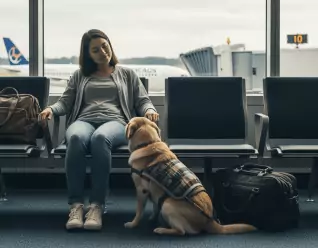

9 Things to Look for in ESA Crates And Carriers
by Haley Mills
Last updated: April 24, 2024
Verified and Approved by:
Angela Morris,
MSW, LCSW
Fact Checked

When it comes to traveling with your emotional support animal (ESA), ensuring their safety is of utmost importance. One way to provide that security is by using a crash-tested ESA crate or carrier. These products have undergone rigorous testing to meet safety standards and regulations, giving you peace of mind during your journeys.
This article will explore the various crash-tested ESA crates and carriers available in the market. We will delve into the safety standards and regulations that govern these products, as well as the crash testing methods and procedures used. Additionally, we will discuss the results and ratings of the tested crates and carriers, highlighting the top-rated options for optimal crash safety. So, if you’re looking for a reliable and secure way to transport your ESA, keep reading to discover the best options and learn about the features to look for in an ESA crate or carrier.
Safety Standards and Regulations for ESA Crates and Carriers
We know that crash testing is essential for ensuring the safety of ESA crates and carriers, but what are the specific safety standards and regulations that govern their design and construction? The Federal Aviation Administration (FAA) is responsible for setting the safety standards for ESA crates and carriers used in air travel. According to the FAA, these crates and carriers must be constructed with durable materials that can withstand crash forces. They must also have secure latches and locks to prevent accidental openings during transport. Additionally, the crates and carriers must provide adequate ventilation and visibility for the comfort of the ESA.
In addition to the FAA regulations, safety standards are set by organizations such as the Center for Pet Safety (CPS). TO DETERMINE THEIR SAFETY AND EFFECTIVENESS, the CPS conducts rigorous crash tests on pet products, including ESA crates and carriers. They evaluate factors such as structural integrity, restraint system effectiveness, and ease of use. ESA crates and carriers that pass the CPS crash tests are awarded a safety certification, which can provide pet owners with peace of mind when traveling with their ESA. Overall, the safety standards and regulations for ESA crates and carriers ensure that these products are designed and constructed to provide maximum protection for pets and passengers during travel.
Crash Testing Methods and Procedures
In evaluating the safety of ESA crates and carriers, it is essential to examine the crash testing methods and procedures used thoroughly. Crash testing is conducted to simulate real-life scenarios and determine how well the crates and carriers protect the animals in the event of a crash. The methods and procedures used in these tests should adhere to specific guidelines to ensure accurate and reliable results.
One common crash-testing method involves using a crash-test dummy that simulates the weight and size of an average animal. The dummy is placed inside the crate or carrier and secured using the same methods that would be used with a live animal. The crate or carrier is subjected to different crash scenarios, such as frontal or side impact collisions, to assess its performance. High-speed cameras and sensors are used to capture data on the forces experienced by the dummy and the structural integrity of the crate or carrier.
Another important aspect of crash testing is the evaluation of the crate or carrier’s ability to withstand forces and prevent the animal from being ejected or injured during a crash. This involves assessing the crate or carrier’s structural strength, materials used, and the effectiveness of the securing mechanisms. The tests should also consider the potential for secondary injuries, such as the animal hitting its head against the crate or carrier walls. Overall, crash testing methods and procedures play a crucial role in determining the safety of ESA crates and carriers and ensuring the well-being of animals during travel.
Results and Ratings of ESA Crates and Carriers
Discover the impressive ratings and results of the safety evaluations conducted on these top-notch crates and carriers for your ESA. These crash-tested crates and carriers have undergone rigorous testing to ensure the utmost safety and protection for your emotional support animal. The results of these evaluations have been outstanding, with many of these products earning top ratings for their excellent performance during simulated crash scenarios.
One key factor contributing to the high ratings of these crates and carriers is their sturdy construction. These products are made from durable materials that can withstand the impact of a crash, providing a secure and protective environment for your ESA. Many of these crates and carriers also feature reinforced walls and secure latching systems, further enhancing their safety features.
Another aspect that sets these crates and carriers apart is their innovative design. These products have been engineered with the safety of your ESA in mind, incorporating features such as crash-resistant doors and padded interiors. These design elements help minimize the risk of injury during a crash, ensuring your ESA remains safe and secure.
In conclusion, the results and ratings of these crash-tested ESA crates and carriers are truly impressive. These products have proven their ability to provide high safety and protection for your emotional support animal, giving you peace of mind during your travels. Whether you’re going on a road trip or flying to a new destination, investing in one of these top-notch crates or carriers is a smart choice to ensure the well-being of your ESA.
Top-Rated ESA Crates and Carriers for Crash Safety
A crash-tested crate or carrier is one of the highest-rated options for keeping your emotional support animal safe during travel. These crates and carriers undergo rigorous testing to ensure they can withstand a crash’s impact and protect your pet. They are designed with reinforced materials and secure locking systems to prevent your animal from escaping in the event of an accident.
Many top-rated crash-tested crates and carriers come with additional safety features such as seatbelt attachments or built-in harnesses to secure your pet during travel. They are also designed to provide optimal ventilation and comfort for your animal, ensuring that they remain calm and relaxed throughout the journey.
When choosing a crash-tested crate or carrier for your emotional support animal, it is important to consider the size and weight of your pet to ensure a proper fit. Additionally, it is recommended to check the crash safety ratings and reviews of different brands to find the best option for your specific needs.
Overall, investing in a crash-tested crate or carrier is crucial in ensuring the safety and well-being of your emotional support animal during travel. By choosing a top-rated option, you can have peace of mind knowing that your pet is protected in the event of a crash.
Features to Look for in a Crash-Tested ESA Crate or Carrier
Ensure that your furry friend stays safe and secure during travel by considering these essential features when selecting a crate or carrier. Sturdy construction is one of the most important features to look for in a crash-tested ESA crate or carrier. The crate or carrier should be made of durable materials that can withstand impact and provide protection for your pet in the event of a collision. Look for crates or carriers that are made of reinforced plastic or metal, as these materials are known for their strength and durability.
Another important feature to consider is the presence of secure latching mechanisms. The crate or carrier should have strong and reliable locks or latches to keep your pet safe during travel. It is also advisable to look for crates or carriers that have multiple latching points, as this will provide added security and prevent accidental opening. Additionally, consider the size and design of the crate or carrier. It should be spacious enough for your pet to move around comfortably but not too large that they can be thrown around during a crash. Look for crates or carriers with a solid and stable base to prevent tipping over. By choosing a crash-tested ESA crate or carrier with these essential features, you can have peace of mind knowing that your furry friend is safe and secure during your travels.
Tips for Properly Securing Your ESA in a Crate or Carrier
Properly securing your ESA in a crate or carrier is essential for their safety and well-being during travel. When it comes to securing your ESA, there are a few tips to keep in mind. Firstly, make sure the crate or carrier is the appropriate size for your ESA. It should be large enough for them to stand, turn around, and lie down comfortably but not so large that they can be thrown around during sudden stops or turns. Additionally, using a secure and sturdy crate or carrier that has been tested and meets safety standards is crucial. This will provide an extra layer of protection in the event of an accident.
Next, securing the crate or carrier in your vehicle is important. Use seat belts or other secure straps to ensure that the crate or carrier is tightly fastened and unable to move around. This will prevent any potential injuries to your ESA and other passengers in the vehicle. It’s also a good idea to place the crate or carrier in a secure and stable location, such as the backseat or cargo area. Avoid placing it in the front seat or on the floor where it could shift or be damaged in a collision.
Taking the time to secure your ESA in a crate or carrier properly is crucial for their safety and well-being during travel. Following these tips ensures that your furry friend is protected and comfortable throughout the journey.
Importance of Using a Crash-Tested ESA Crate or Carrier
To truly protect your emotional support animal during travel, it is crucial that you invest in a crate or carrier that has undergone rigorous crash testing. Crash-tested ESA crates and carriers are specifically designed and engineered to withstand the impact forces that can occur during a car accident. These products have been tested extensively to ensure that they provide the highest level of safety for your furry friend.
One of the main reasons why using a crash-tested ESA crate or carrier is so important is because it can greatly reduce the risk of injury to your emotional support animal in the event of a crash. These crates and carriers are built with reinforced materials and structural integrity, which helps to prevent them from collapsing or breaking apart during an accident. This means that your ESA will be securely contained and protected, minimizing the chances of them getting injured or escaping from the crate or carrier.
Additionally, crash tested ESA crates and carriers often come with additional safety features such as seatbelt attachments or built-in harnesses. These features help to further secure your emotional support animal in place and prevent them from being thrown around or ejected from the crate or carrier in the event of a crash. By using a crate or carrier that has undergone crash testing, you can have peace of mind knowing that you are providing the best possible protection for your ESA during travel.
Common Myths and Misconceptions About Crash Testing for ESA Crates and Carriers
Contrary to popular belief, there are many misconceptions surrounding the process of crash testing for crates and carriers used for ESAs. One common myth is that crash testing is unnecessary because pets are generally safe in a vehicle. However, the reality is that accidents can happen at any time, and without proper safety measures in place, pets can be seriously injured or even killed in a crash. Crash testing ensures that crates and carriers meet certain safety standards and can withstand the impact of a collision, protecting the animal inside.
Another misconception is that any crate or carrier will provide sufficient protection in a crash. However, not all crates and carriers are created equal. Crash-tested crates and carriers undergo rigorous testing to ensure they can withstand the forces of a collision without breaking apart or collapsing. They are designed with reinforced materials and structural integrity to provide maximum protection for the pet inside. Using a crate or carrier that has not been crash-tested can put your ESA at risk in the event of an accident.
In conclusion, dispelling the myths and misconceptions surrounding crash testing for ESA crates and carriers is important. Crash testing is a crucial step in ensuring your pet’s safety during travel, and using a properly tested crate or carrier can greatly reduce the risk of injury or harm in the event of a crash.
Are ESA Crates and Carriers Essential for Traveling with Emotional Support Animals?
Yes, ESA crates and carriers are essential for traveling with emotional support animals. These specially designed products ensure the safety and comfort of your traveling with emotional support animal, making the journey stress-free for both the owner and the animal.
Conclusion
In conclusion, when it comes to the safety of your ESA during travel, it is crucial to choose a crate or carrier that has been crash tested and meets safety standards and regulations. The results and ratings of these crash tests can provide valuable information about the level of protection they offer in the event of an accident. By investing in a top-rated ESA crate or carrier, you can have peace of mind knowing that your furry friend is secure and protected during travel.
When selecting a crash-tested ESA crate or carrier, there are several features to look for. These include sturdy construction, secure latching mechanisms, and proper ventilation. Additionally, it is important to properly secure your ESA within the crate or carrier using a harness or leash attachment, as this can greatly reduce the risk of injury in the event of a crash.
Despite some common myths and misconceptions about crash testing for ESA crates and carriers, it is important to remember that these tests are conducted to ensure the safety of your ESA. By choosing a crate or carrier that has been crash tested and meets safety standards, you are taking an important step in protecting your furry friend during travel. So, make sure to do your research and select a top-rated ESA crate or carrier for the ultimate peace of mind.
Frequently Asked Questions
Are there any specific weight limits for ESA crates and carriers?
Yes, there are specific weight limits for ESA crates and carriers. These limits ensure the safety and comfort of both the emotional support animal and the person traveling with them.
Can an ESA crate or carrier be used for travel on airplanes?
Yes, an ESA crate or carrier can be used for travel on airplanes. However, it is important to check with the specific airline regarding their regulations and requirements for traveling with an ESA.
Are there any specific crate or carrier materials recommendations that provide better crash safety?
There are no specific recommendations for crates or carrier materials that provide better crash safety, as there are no crash testing standards for ESA crates and carriers.
How often should an ESA crate or carrier be replaced for optimal crash safety?
For optimal crash safety, replacing an ESA crate or carrier is recommended every 5-7 years. Over time, the materials may degrade and become less effective in protecting your pet during a collision.
What is the average cost range for a crash-tested ESA crate or carrier?
The average cost range for a crash-tested ESA crate or carrier can vary, but generally, prices range from $100 to $300. Investing in a high-quality, certified product is important to ensure optimal safety for your emotional support animal.
Certify Your Emotional Support Animal Today

Why You Can Rely on Us?
At Wellness Wag, we believe your pet deserves care rooted in both science and compassion. Each article is carefully researched, written in clear language for pet owners, and then reviewed by qualified professionals to ensure the information is evidence-based, current, and practical for real-life care. Our goal is to help you feel confident in making informed decisions about your pet’s health and well-being.
Reviewed by
Angela Morris, MSW, LCSW
Angela is a licensed clinical social worker with 20 years of experience in patient advocacy and community mental health. She has assisted numerous clients with ESA evaluations and brings a deep understanding of disability accommodations, ensuring that all information is accurate, supportive, and practical.

Written by :
Haley Mills
Last Updated :
April 24, 2024












